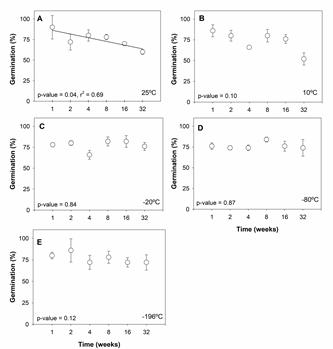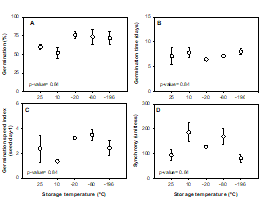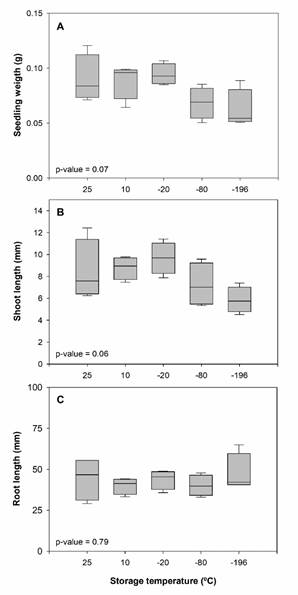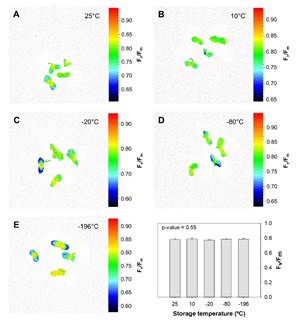Agrociencia Uruguay
Universidad de la República, Uruguay
ISSN-e: 2730-5066
Periodicity: Bianual
vol. 26, no. 1, e678, 2022
Received: 07 April 2021
Accepted: 21 October 2021
Published: 23 February 2022
Corresponding author: gioo.esteves@gmail.com
Facultad de Agronomía, Universidad de la República - INIA
Abstract:
Bowdichia virgilioides Kunth is a tree species native to the Brazilian Cerrado that has been listed as an endangered species due to its overexploitation in the last decades. Given its slow and difficult propagation in natural environments, propagation in plant nurseries appears as an interesting strategy to preserve this endangered species. Therefore, in this study we employed a wide range of temperatures (i.e. from -25°C to -196°C) to store seeds of B. virgilioides in the short-term, and evaluated its efficiency by assessing seed germination rate, speed index, time and synchrony, as well as seedling growth and quality. Germination percentage was only slightly negatively affected by storage time (up to 32 weeks) at 25°C. Despite that, after 32 weeks of storage, all storage temperatures resulted in similar seed germination parameters and seedling growth and quality. Overall, our results highlight that the seeds of this species can be stored in the short-term at a wide range of temperatures, facilitating large-scale propagation in plant nurseries.
Keywords: cryopreservation, germination, orthodox seeds, seed storage, seedling growth.
Resumen:
Bowdichia virgilioides Kunth es una especie arbórea nativa del bosque Cerrado brasileño que ha sido considerada en peligro de extinción debido a su sobreexplotación en las últimas décadas. Dada su lenta y difícil propagación en ambientes naturales, la propagación de plantas en viveros aparece como una estrategia interesante para preservar esta especie en peligro de extinción. Por lo tanto, en este estudio empleamos un amplio rango de temperaturas (es decir, desde -25 °C a -196 °C) para almacenar semillas de B. virgilioides en un corto plazo y evaluar su eficiencia a través de la tasa de germinación de semillas, el índice de velocidad, el tiempo y la sincronía, así como el crecimiento y la calidad de las plántulas. El porcentaje de germinación se vio afectado ligeramente por el tiempo de almacenamiento (de hasta 32 semanas) a una temperatura de 25 °C. A pesar de eso, después de 32 semanas de almacenamiento, todas las temperaturas de almacenamiento dieron como resultado la germinación de las semillas, con crecimiento y calidad de plántulas similares. En general, nuestros resultados destacan que las semillas de esta especie se pueden almacenar en un corto plazo en una amplia gama de temperaturas, facilitando así la propagación a gran escala en viveros.
Palabras clave: criopreservación, germinación, semillas ortodoxas, almacenamiento de semillas, crecimiento de plántulas.
Resumo:
Bowdichia virgilioides Kunth é uma espécie arbórea nativa do Cerrado brasileiro que tem sido considerada ameaçada de extinção devido à sua superexploração nas últimas décadas. Por ter uma propagação lenta e dificultada em ambientes naturais, a propagação em viveiros de plantas surge como uma estratégia interessante para preservar esta espécie ameaçada de extinção. Portanto, neste estudo, empregamos uma ampla gama de temperaturas (i.e., de -25°C a -196°C) para armazenar sementes de B. virgilioides em curto prazo e avaliamos sua eficiência através da taxa de germinação de sementes, índice de velocidade, tempo e sincronia, bem como crescimento e qualidade da plântula. A porcentagem de germinação sofreu pequenas reduções com o tempo de armazenamento (de até 32 semanas) apenas na temperatura de 25°C. Apesar disso, após 32 semanas de armazenamento, todas as temperaturas de armazenamento resultaram em parâmetros de germinação de sementes, crescimento e qualidade de plântulas semelhantes. De forma geral, nossos resultados demonstram que as sementes dessa espécie podem ser armazenadas no curto prazo em uma ampla faixa de temperatura, facilitando a propagação da espécie em larga escala em viveiros.
Palavras-chave: criopreservação, germinação, sementes ortodoxas, armazenamento de sementes, crescimento de plântulas.
1. Introduction
Bowdichia virgilioides Kunth (Fabaceae) is a tree species native to the Brazilian Cerrado(1). This species is considered to be pioneer, being well adapted to poor and dry soils and burnt areas, which are typical to Cerrado(2)(3). It bears small (3 to 5 mm in diameter) orthodox seeds that exhibit a strong integumentary dormancy that hinders its propagation in natural environments(4). Alongside its low propagation rate in natural environments, the overexploitation of this species for pharmacological purpose resulted in a considerable reduction in its populations to critical levels, which led to its classification as an endangered species of Brazilian flora(5).
Developing an efficient protocol for plant propagation in nurseries is of paramount importance as part of a recovery strategy to preserve endangered species of slow and hampered natural propagation. In this scenario, seed propagation appears as the most simple and low-cost method for this purpose. Although many studies have shown simple methods to overcome its dormancy(6)(7), no information regarding the most efficient condition for seed storage is currently found in the literature. Because plant metabolism is intrinsically dependent on temperature, lowering the temperature of storage has been long known to extend seed survival and longevity(8)(9).
In traditional seed banks, seeds are generally kept at a temperature of 10°C and relative humidity of 40% in the medium to long-term(10). However, this type of storage does not prevent the genetic erosion over time, especially for recalcitrant seeds, which justifies the utilization of cryogenic temperatures for the conservation of endangered species native to Cerrado, such as B. virgilioides(11). In this scenario, and because seed characteristics of B. virgilioides imply an orthodox behavior, which typically tolerate low temperatures(9), seed cryopreservation at ultra-low temperatures might function as an alternative for germplasm conservation of this species, ensuring its genetic stability and high physiological seeds quality(12)(13)(14). Therefore, in this study we evaluated the longevity of B. virgilioides seeds by assessing germination rate, time, speed index and synchrony, following the storage of seeds at warm and ultra-low temperatures in the short-term. Additionally, we assessed seedling growth and quality through foliar chlorophyll fluorescence(15) from seeds at contrasting temperatures.
2. Materials and methods
Seeds of B. virgilioides were collected during the summer of 2017 from 10 natural populations (i.e. 2-3 plants per population) of this species in an area comprised of typical Cerrado vegetation located in the proximities of Bom Despacho (19° 44' 09" S, 45° 15' 07" W, 768 m above the sea level), Brazil. Fruits were harvested, packaged in paper bags and taken to the laboratory. Seeds were carefully removed from fruits by hand and immediately stored in aluminum foil bags at five contrasting temperatures: c. 25°C (room temperature), c. 10°C (in a common refrigerator), -20°C (in a freezer), -80°C (in an ultra-freezer), and -196°C (in liquid nitrogen) for 1, 2, 4, 8, 16 and 32 weeks. A set of 6 repetitions of 25 seeds each had their water content assessed after being dried in oven until constant weight, according to the Brazilian Seed Analysis Rules(16).
Prior to the germination tests, seeds were treated to overcome dormancy by immersion in water bath at 37ºC for 3 min, followed by scarification by immersion in concentrated sulfuric acid for 10 min to overcome dormancy(17)(18). Seeds were then placed in germination boxes containing vermiculite moistened with distilled water until the point of runoff. The boxes were placed in a growth room at room temperature (c. 25 ± 2°C) and irradiance of c. 40 µmol photon m2 s-1, and seed germination was daily assessed for 15 days. Seeds were considered to be germinated after the emergence of the primary root with a length greater than 1 mm. At the end, percentage germination, germination time, speed index and synchrony(19) were calculated. In addition to assessing seed longevity and germinability, we assessed the seedlings fresh weight and the maximum quantum efficiency of photosystem II (Fv/Fm) after 15 days. The Fv/Fm was quantified between 9:00 and 11:00 AM in dark-adapted cotyledons of seedlings using an image fluorometer (FluorCam, Photon Systems Instruments, Drasov, Czech Republic)(20).
The experimental design was completely randomized with 5 storage temperature and 6 storage times. Germination assessments were performed in 4 repetitions of 25 seed (n = 4) and seedling characterization in 4 repetitions of all seedlings (n = 4) per storage condition and storage time. Since there was no difference in any of the evaluated parameters between storage time (see percentage germination in Fig. 1; the remaining data are not shown), we utilized data from seeds stored for the longest time (i.e. 32 weeks) (Figs. 2-4). Means were compared by the non-parametric Kruskal-Wallis test at the 95% confidence level or through linear regressions. The statistical analyses were conducted using R (version 4.0.3) and the plots constructed using SigmaPlot 14.0(21).
 Figure 1
Germination of Bowdichia virgilioides seeds stored for up to 32 weeks at
contrasting temperatures. Data are mean ± SE, n = 4. A linear regression
was fitted in A and the p-value is depicted within this plot. For the remaining
plots, p-values for linear regressions were higher than 0.05 (see values within
each plot), as well as means (n = 4) were similar between storage
times according to Kruskal-Wallis test at the 95% confidence level
Figure 1
Germination of Bowdichia virgilioides seeds stored for up to 32 weeks at
contrasting temperatures. Data are mean ± SE, n = 4. A linear regression
was fitted in A and the p-value is depicted within this plot. For the remaining
plots, p-values for linear regressions were higher than 0.05 (see values within
each plot), as well as means (n = 4) were similar between storage
times according to Kruskal-Wallis test at the 95% confidence level
 Figure 2
Germination A germination time B germination speed index C and synchrony D of Bowdichia virgilioides seeds stored for up to 32 weeks at contrasting temperatures Data are mean ± SE n 4 The pvalues for linear regressions were higher than 005 see values within each plot as well as means n 4 were similar between storage temperatures according to KruskalWallis test at the 95% confidence level
Figure 2
Germination A germination time B germination speed index C and synchrony D of Bowdichia virgilioides seeds stored for up to 32 weeks at contrasting temperatures Data are mean ± SE n 4 The pvalues for linear regressions were higher than 005 see values within each plot as well as means n 4 were similar between storage temperatures according to KruskalWallis test at the 95% confidence level
3. Results and discussions
The B. virgilioides seed lot characterization before storage resulted in approximately 52,000 seeds per kilogram and the water contents for scarified and non-scarified seeds were 9.25% and 9.92%, respectively. Such low water content is consistent with values found for orthodox seeds(9) and in agreement with previous results obtained for this species(6).
Percentage germination only decreased with time at 25°C. At all other storage temperatures evaluated in this study, germination remained similarly high up to 32 weeks (see p-values > 0.05 from B to E in Figure 1). Overall, germination started three days after sowing and reached high levels (i.e. always above 67% and approximately 75% when all data was taken together). Germination speed index, time and synchrony did not decrease with storage time for any of the storage conditions (data not shown). Because, germination decreased with time at 25°C, we decided to utilize the data obtained after 32 weeks of storage to compare the storage treatments as regarding their ability to preserve seed germination, and we observed that all storage temperatures resulted in similar percentage germination, germination speed index, time and synchrony (see p-values > 0.05 for all parameters in Figure 2).
Taken together, these results highlight that the seeds of this orthodox species can be stored at an extremely wide range of temperatures in the short-term, but lower temperatures (from 10°C to -196°C) seem to be more effective in maintaining seed viability for longer periods. Additionally, we observed that ultra-low temperatures, at which seed metabolism is completely suspended(14)(22), are not necessarily needed to maintain seed longevity in the short-term; however, further studies are necessary to assess whether this can be an interesting alternative in the medium to long-term.
It is noteworthy that seeds of B. virgilioides were frozen without the utilization of any cryoprotectant(23), and despite that, they were able to germinate as fast and efficiently as seeds stored at warmer temperatures. It is likely that the low water content prevented the formation of intracellular ice crystals that can damage the endomembrane system and cause the semi-permeability loss and cellular compartmentalization(24). Further studies assessing storage of B. virgilioides seeds in the long-term might provide researchers with the information on whether the use of cryoprotectants will be necessary under this condition.
 Figure 3
Total weight (A), shoot length (B) and root length (C) of Bowdichia virgilioides
seedlings germinated from seeds stored for 32 weeks at contrasting
temperatures. The two extreme lines of the boxplot (whiskers) show the 10 and
90% percentiles; the two bounds of the box, the 25 and 75% percentiles, and the
center thick line, the median. Means (n = 4) were similar between
storage temperatures according to Kruskal-Wallis test at the 95% confidence
level
Figure 3
Total weight (A), shoot length (B) and root length (C) of Bowdichia virgilioides
seedlings germinated from seeds stored for 32 weeks at contrasting
temperatures. The two extreme lines of the boxplot (whiskers) show the 10 and
90% percentiles; the two bounds of the box, the 25 and 75% percentiles, and the
center thick line, the median. Means (n = 4) were similar between
storage temperatures according to Kruskal-Wallis test at the 95% confidence
level
Alike all seed germination parameters, seedling growth was similar in spite of the storage time (data not shown) and the storage temperature (see p-values > 0.05 for all parameters in Figure 3). Seedlings were on average c. 0.07 g and exhibited a c. 8 mm shoot length and c. 45 mm root length. The seedlings size is generally used to identify the most vigorous seeds(25), and these data show that seed vigor of B. virgilioides was not negatively affected by storage time nor storage temperature. Data on Fv/Fm of seedling cotyledons (Figure 4) demonstrate no damage at the leaf level (i.e. all values are around 0.78, after seed storage for 32 weeks for all storage temperatures), and are in agreement with healthy seedlings(26).
 Figure 4
Maximum quantum efficiency of the photosystem II (Fv/Fm)
of cotyledons of Bowdichia virgilioides seedlings germinated from seeds stored for
32 weeks at contrasting temperatures. Representative images for each storage
temperature are shown in A-E and means are shown in F. Data are mean ± SE, n
= 4. Means (n = 4) were similar between storage temperatures according
to Kruskal-Wallis test at the 95% confidence level
Figure 4
Maximum quantum efficiency of the photosystem II (Fv/Fm)
of cotyledons of Bowdichia virgilioides seedlings germinated from seeds stored for
32 weeks at contrasting temperatures. Representative images for each storage
temperature are shown in A-E and means are shown in F. Data are mean ± SE, n
= 4. Means (n = 4) were similar between storage temperatures according
to Kruskal-Wallis test at the 95% confidence level
4. Conclusions
Our findings demonstrate that although germination percentage slightly decreases with time at 25°C, seeds of B. virgilioides can be efficiently stored at a wide range of temperatures in the short-term and still maintain high germinability, synchrony and short germination time, as well as the production of vigorous seedlings. Additional studies, however, are necessary to determine whether lower temperatures, including cryopreservation, would be a better alternative for seed storage in the medium to long-term, given the decrease in germination percentage at room temperature.
Acknowledgments
The authors acknowledge the Coordenação de
Aperfeiçoamento de Pessoal de Nível Superior (CAPES), Conselho Nacional de
Desenvolvimento Científico e Tecnológico (CNPq), and
Fundação de Amparo à Pesquisa do Estado de Minas Gerais (FAPEMIG) for the financial support.
References
1. Lima HC, Cardoso DBOS. Bowdichia. In: Lista de Espécies da Flora do Brasil [Internet]. Rio de Janeiro: Jardim Botânico do Rio de Janeiro; 2015 [cited 2022 Feb 08]. Available from: https://bit.ly/3LB7563.
2. Arantes CS, Prado Júnior JÁ, Sousa JR, Vale VS, Oliveira RMC. Ação Facilitadora de Bowdichia Virgilioides Kunth. (Fabaceae) na Colonização de Espécies em uma Área de Cerrado Sentido Restrito. Caminhos de Geogr. 2015;16(53):15-26.
3. Campos Filho EM, Sartorelli PAR. Guia de identificação de espécies-chave para a restauração florestal na regiaõ de Alto Teles Pires Mato Grosso. São Paulo: The Nature Conservancy; 2015. 248p.
4. Smiderle OJ, Schwengber LAM. Superação da dormência em sementes de paricarana (Bowdichia virgilioides Kunth.). Rev Bras Sementes. 2011;33(3):407-14.
5. CNCFlora. Bowdichia virgilioides. In: Lista Vermelha da flora brasileira [Internet]. Versão 2012.2. Rio de Janeiro: Instituto de Pesquisas Jardim Botânico do Rio de Janeiro; 2012 [cited 2022 Feb 08]. Available from: https://bit.ly/3LAldwD.
6. Albuquerque KS, Guimarães RM, Almeida ÍFD, Clemente ADCS. Métodos para a superação da dormência em sementes de Sucupira-preta (Bowdichia virgilioides Kunth.). Ciênc agrotec. 2007;31(6):1716-21.
7. Santos JF, Mendonça AVR, Souza MO. Dormancy of Bowdichia virgilioides Kunth seeds. Cientifica. 2020;48(3):250-6.
8. Liu U, Cossu TA, Davies RM, Forest F, Dickie JB, Breman E. Conserving orthodox seeds of globally threatened plants ex situ in the Millennium Seed Bank, Royal Botanic Gardens, Kew, UK: the status of seed collections. Biodivers Conserv. 2020;29(9-10):2901-49.
9. Solberg SØ, Yndgaard F, Andreasen C, von Bothmer R, Loskutov IG, Asdal Å. Long-Term Storage and Longevity of Orthodox Seeds: A Systematic Review. Front Plant Sci [Internet]. 2020 [cited 2022 Feb 08];11:1007. Doi: 10.3389/fpls.2020.01007.
10. Goldfarb MMEDM, Martins MED, Mata M, Pimentel LW, Severino LS. Teor de Água Limite para Crioconservação das Sementes de Pinhão manso (Jatropha curcas L.). Rev Bras Prod Agroind. 2008;10(2):121-9.
11. Gonzaga TWC, Mata MERMC, Silva H, Duarte MEM. Crioconservação de Sementes de Aroeira (Astronium urundeuva Engl.), e Baraúna (Schinopsis brasiliensis Engl.). Rev Bras Prod Agroind. 2003;5(2):145-54.
12. Pritchard HW, Nadarajan J. Cryopreservation of orthodox (desiccation tolerant) seeds. In: Reed BM, editor. Plant Cryopreservation: A Practical Guide. New York: Springer; 2008. p. 485-501.
13. Ballesteros D, Fanega-Sleziak N, Davies RM. Cryopreservation of seeds and seed embryos in orthodox-, intermediate-, and recalcitrant-seeded species. In: Cryopreservation and Freeze-Drying Protocols. New York: Humana; 2021. p. 663-82.
14. Engelmann F. Use of biotechnologies for the conservation of plant biodiversity. In Vitro Cell Dev Biol Plant. 2011;47(1):5-16.
15. Guadagno CR, Ewers BE, Speckman HN, Aston TL, Huhn BJ, DeVore SB, Ladwig JT, Weinig C. Dead or alive? using membrane failure and chlorophyll a fluorescence to predict plant mortality from drought. Plant Physiol. 2017;175(1):223-34.
16. Ministério da Agricultura, Pecuária e Abastecimento (BR). Regras para análise de sementes. Brasília: Mapa/ACS, 2009. 399p.
17. Cruz AF, Passos MAA, José AAS, Torres SB, Oliveira IS. Métodos para análise de sementes de Bowdichia virgilioides Kunth Methods for analysis of seeds of Bowdichia virgilioides Kunth. Sci For. 2012;40(93):77-84.
18. Boaventura Filho MA, Leite MA, Mc Leod L, Santos BR, Santos Filho PR. Spontaneous vegetative propagules differentiation in Bowdichia virgilioides seedlings maintained at MS basal medium. Rev Ceres. 2021;68(1):55-60.
19. Ranal MA, Santana DG, Ferreira WR, Rodrigues CM. Calculating germination measurements and organizing spreadsheets. Rev Bras Bot. 2009;32(4):849-55.
20. Esteves GF, Bressanin LA, Souza KRD, Silva AB, Mantovani JR, Marques DM, Magalhães PC, Pasqual M, Souza T. Do tailings from the Mariana, MG (Brazil), disaster affect the initial development of millet, maize, and sorghum? Environ Sci Pollut Res. 2020;27(31):38662-73.
21. Systat Software Inc. SigmaPlot for Windows [Internet]. Version 14.0. San Jose: Systat Software Inc.; 2014 [cited 2022 Feb 08]. Available from: https://bit.ly/3BnyeVp.
22. Silva TL, Gomes HT, Pereira JES. Designing ex-situ conservation strategies for seeds storage of Piper aduncum and P. hispidinervum through cryopreservation and low-temperature techniques. J For Res. 2017;22(6):380-5.
23. Ferrari EAP, Colombo RC, Faria RTD, Takane RJ. Cryopreservation of seeds of Encholirium spectabile Martius ex Schultes f. by the vitrification method. Rev Ciênc Agron. 2016;47(1):172-7.
24. Kaviani B, Abadi DH, Torkashvand AM, Hoor SS. Cryopreservation of seeds of lily [Lilium Iedebourii (Baker) Bioss]: Use of sucrose and dehydration. Afr J Biotechnol. 2009;8(16):3809-10.
25. Graham IA. Seed Storage Oil Mobilization. Annu Rev Plant Biol. 2008;59(1):115-42.
26. Guidi L, Lo Piccolo E, Landi M. Chlorophyll Fluorescence, Photoinhibition and Abiotic Stress: Does it Make Any Difference the Fact to Be a C3 or C4 Species? Front Plant Sci [Internet]. 2019 [cited 2022 Feb 08];10:174. Doi: 10.3389/fpls.2019.00174.
Author notes
gioo.esteves@gmail.com
Additional information
Author
contribution statement: All
authors contributed equally to this study.
Editor: Gustavo
Balmelli (https://orcid.org/0000-0002-5762-4207) Instituto Nacional de
Investigación Agropecuaria
(INIA), Tacuarembó, Uruguay
Alternative link
http://agrocienciauruguay.uy/ojs/index.php/agrociencia/article/view/678/1094 (pdf)









